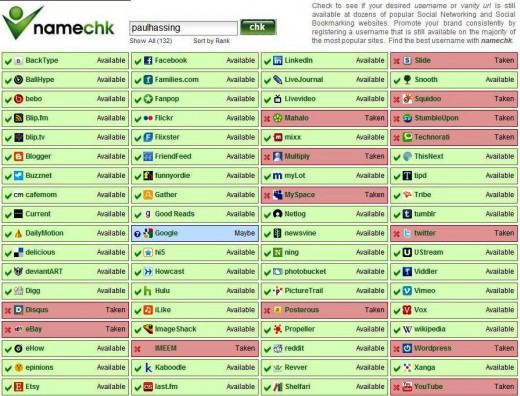Social Media

Practical Social Media Tips
This lens contains questions and answers about blogging, Twitter, LinkedIn and other social media (Web 2.0) applications.
My clients are getting very interested in this stuff.
Rather than repeat myself 100 times, I've created this lens so they (and you) can learn at leisure.
At this stage, I'm posting queries and responses as they arise. Down the track, I'll put everything in an intuitive order for easy access.
As I'm still learning myself, I warmly welcome your frank response to anything on this lens.
(Thanks to 7-how-7 for the beautiful pic.)
Social media spot check - I've covered my most important bases ... for now!

www.namechk.com searches all social media applications to see if your name's being used.
The screenshot above shows how I'm doing. While it covers the most popular social media applications, you can also run the program for all 132 applications!
You'd do well to check out these applications to see who's doing what with your personal, company and product names.
It'd also be a good idea to register (and thus lock down) free names in at least the really important channels (e.g. YouTube, Facebook, LinkedIn).
As this task would be more routine than expert (but still quite time consuming) it could be done cost effectively by an enthusiastic student with plenty of time on her hands.
Failing that, a junior IT person in your company could do it (and thus become a very valuable internal resource).
Failing that, I could do it myself.

The future of damage control
Sometimes a press release just won't cut it
The other day I was busy convincing a client to participate in social media.
At the perfect moment, a dramatic case in point featured on the front page of my online daily newspaper.
It concerned the apparent inability of HP computers to track 'black' people's faces.
A potentially brand-crippling (though rather entertaining) YouTube video was circling the globe (more than 1.7 million views at time of writing).
Yet just as spectacular (to my mind, anyway) was HP's instant response on their blog.
Rather than rail against or try to discredit the man who made the flaw-demonstrating video, they thanked him for his feedback.
They even provided a link to the video!
They then admitted that they:
1. Didn't know the cause of the problem.
2. Had some good ideas as to what it might be.
3. Were working hard to sort it out.
Compare this to the bullsh*t, no-fault, no-blame, no-nothing damage-control press releases of old.
I'd just finished reading Groundswell, which predicts that scenarios like this will occur with increasing frequency.
(I keep mentioning this book, but by golly it's a ripper.)
Anyway, I sent my client the story and wrote, 'If the sh*t ever hits the fan with one of your products, you need to be able to respond this fast. You have been warned.'
We're on friendly terms. And she got the point.
Then came the ultimate irony: one week later, her company had to do a major product recall.
We're now talking blogs.
Are you?

Reach out
If you find a blogger who mentions your products or services, leave a comment or get your representative to do it.
Most blogs let you add a link (also called a URL – short for Uniform [or Universal] Resource Locator) back to your site when you comment.
This is good for creating fresh visitor traffic and improving your online search ranking performance.
It also shows that your organisation is active in the social media space (and therefore ’switched-on’ in the minds of Generation Y and younger audiences).
Better still, if your competitors don’t follow your lead, you may open a point of difference that they can never close.
Your social media participation may also prompt blog owners to ask you or your representative for content – or even an interview.
At this point, you can start steering the conversation your way.
Finally, consistent online participation by you or your rep provides a contact name for anyone with good or bad news to impart.
Thus, each blogger your cultivate is like a listening post in no-man’s land.
The more you have, the better your field intelligence – which is vital for the battles ahead.
By promoting good things and resolving bad, you build and optimise your brand many times faster than has ever been possible.

How to measure blog success
What gets measured gets done
Blogging has yielded some spectacular corporate successes, which are detailed in the seminal book Groundswell.
I strongly recommend you read this book.
I currently use six ways to measure blogging success:
1. Site statistics.
I check my stats several times every day to see which blogs are sending traffic to which websites. I can even see which blog posts are performing better than others.
2. Blog ranking.
I register my blogs with a ranking site that shows how well they’re performing relative to other blogs in their topic. This info is updated hourly.
3. Comments.
When people leave comments, that means they’re visiting and reading. The more comments the better (though I do have to weed out spammers and ravers).
4. Subscriptions.
Even better than comments are subscribes. When a person says YES to an email or RSS (short for Really Simple Syndication) feed of your blog, you know they’re digging it.
Building a subscriber base is the holy grail of blogging, as you can use it for a host of permission marketing initiatives.
5. Sales.
Several new clients have approached me saying something like, ‘I found you via your blog, read your stuff for a while and decided you were the sort of person I wanted to do business with.’
For me, this is the acid test of a blog’s success. After all, that’s one of the main reasons we’re writing the damn thing!
6. Vibe.
In a few short months, my horse breeding client has reported a very positive reaction from clients and industry people.
She’s also feeling freer, as she’s getting prospects to read the blog before asking her questions.
She used to have to spend hours repeating herself to each inquirer.
She’s loving the process of decanting her wisdom to a blog that people can read without bothering her.
It’s much easier for her to fill in the gaps once people have some idea of what she’s on about.
And those who don’t like the blog’s style or content can deselect themselves (as they’re not the sort of people she wants handling her beloved horses anyway).
I’m heading up there for another overnighter soon, collecting photos and stories to keep feeding the blog.
Is social media a fad? - Watch this phenomenal video and decide for yourself.
It's based on Erik Qualman's book Socialnomics.

Turn formus into temples
When searching online for the names of your organisation, products or services, keep a sharp eye out for forums.
This is where people gather to praise, study, discuss or revile what you do.
Often, you’ll see requests for help or information which the forum’s current participants can’t fulfil.
According to Groundswell, if you provide a forum with free tips on how to solve outstanding problems with your goods, users will worship your brand and spread the word.
You can do this task yourself, or delegate it to a product-savvy eager beaver in your organisation as a special assignment.
The results may pleasantly surprise you.

Your emails are blog posts!
A trove of blog posts may already be yours!
Many of my clients understand that they need to blog. Yet they’re thwarted by two mind blocks:
1. What will I write about?
2. How will I find the time?
What they don’t realise is that their blog posts may already be written – in their emails!
Let’s say you make uber-hi-tech vacuum cleaners.
One day, a frantic customer asks how to extract a hamster from the hypohepozappofilter without damaging either.
As a caring, conscientious manufacturer, you (or your tech person) take the time to write and send clear instructions to resolve this problem.
Six months later, you’re about to clean out your email Sent Folder.
DON’T TOUCH THAT FILE!
Your hamster extraction email needs only a brief ‘top and tail’ edit to become a blog post.
And while this problem may not be common, anyone who does suffer it in future will be mighty grateful the answer is already online.
They can search your blog and fix their issue, without the hassle and embarrassment of contacting you.
And you don’t have to waste time considering the situation and writing the solution all over again.
If you don’t keep an email Sent Folder, start today.
If you do, cast your eye over it.
I’ll bet London to a brick you and your staff have written heaps of content that’s begging to be posted on your blog.
I’m not fond of the word ‘leverage’.
But when it means wringing the last atom of utility from a piece of work you’ve already done by reusing it in elegant new ways, I’m a fan!

Organisational benefits of LinkedIn
Professional connections thrive on LinkedIn.
I’ve noticed that one of my larger client’s staff are joining LinkedIn.
I consider this a very good thing, for several reasons.
If all the firm’s managers end up on LinkedIn, they can check each other out and get a better understanding of their various backgrounds and skills.
This could make it easier to assign the right people to projects.
It may also uncover special talents in the workforce the company never knew it had.
This client recently merged. I believe LinkedIn will foster harmony through understanding between members of the two former (and quite different) firms.
It’ll also help my client keep an eye on retrenched staff who may try to ‘augment’ their LinkedIn profile dishonestly by claiming false titles and expertise.
On the other side of the coin, my client could start an ‘alumni’ of good, friendly ex-employees his firm would be glad to have back if their circumstances changed.
This would be very much cheaper than searching for strangers from scratch with recruitment firms.
I’m sure plenty of more options and benefits will reveal themselves. The important thing is to be involved.
If you’re a biggish organisation (public, private or not for profit) LinkedIn is a good, professional forum for your people to gather in.
Links
- The Feisty Empire
Paul Hassing's high-end blogging, copywriting, editing and proofreading services website.





